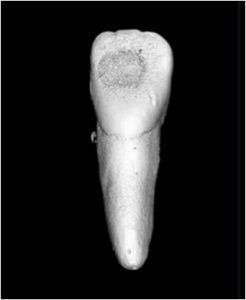Microcomputed tomography (µCT) of teeth can detect demarcated radiolucencies below the enamel-dentin junction (EDJ) that are of noncarious origin, and can therefore be classified as possible developmental irregularities, show study results.
The dental images also revealed a direct pathway that exposed the dentin directly to oral micro-organisms, and could explain the phenomenon of hidden occlusal caries lesions, say the researchers.
“With respect to the possibility of such defects being misjudged as caries lesions on conventional histological images, it seems important for these findings to be taken into account when future histological studies are considered,” remark Jan Kühnisch.
 In total, 203 third molars with clinically sound occlusal fissures or non-cavitated lesions were selected. All specimens were scanned with µCT. Subsequently, each tooth was sectioned, and each slice was investigated by stereomicroscopy. In 7 of 203 molars (3.4%), demarcated radiolucencies below the EDJ were detected by µCT.
In total, 203 third molars with clinically sound occlusal fissures or non-cavitated lesions were selected. All specimens were scanned with µCT. Subsequently, each tooth was sectioned, and each slice was investigated by stereomicroscopy. In 7 of 203 molars (3.4%), demarcated radiolucencies below the EDJ were detected by µCT.
These defects were obviously of non-carious origin, because the µCT images revealed no gradient of demineralization in the dentin. In all cases, a direct pathway between the oral cavity and the dentin was evident. The comparison of the µCT sites with conventional histological images also revealed defects in the dentin.
These results demonstrate that demarcated radiolucencies below the EDJ may not necessarily be caries lesions according to µCT images and may be classified as possible developmental irregularities. To avoid misinterpreting µCT data, dental researchers should carefully consider this condition when analyzing µCT images.
This finding could be due to cellular mechanisms that “failed to establish a tight alignment between the ameloblast and odontoblast cells prior to the establishment of the EDJ,” they suggest.
The results call into question the validity of commonly used histologic reference standards, which might overestimate the presence of caries and influence the performance of current diagnostic methods.
The clinical significance of this finding is that these defects may predispose molar teeth to early-onset caries in occlusal pits and fissures.
- Kühnisch J, Galler M, Seitz M, Stich H, Lussi A, Hickel R, et al. Irregularities below the Enamel-Dentin Junction May Predispose for Fissure Caries. J Dent Res. 2012;91(11):1066-70












